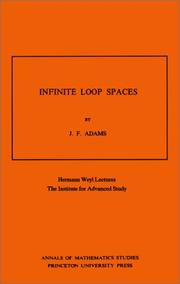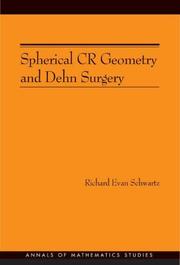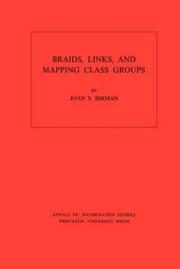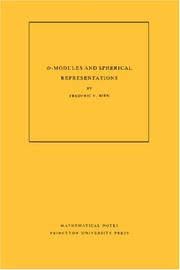| Listing 1 - 7 of 7 |
Sort by
|

ISBN: 0691082073 0691082065 1400821258 Year: 1978 Volume: no. 90 Publisher: Princeton : Tokyo : Princeton University Press University of Tokyo press,
Abstract | Keywords | Export | Availability | Bookmark
 Loading...
Loading...Choose an application
- Reference Manager
- EndNote
- RefWorks (Direct export to RefWorks)
The theory of infinite loop spaces has been the center of much recent activity in algebraic topology. Frank Adams surveys this extensive work for researchers and students. Among the major topics covered are generalized cohomology theories and spectra; infinite-loop space machines in the sense of Boadman-Vogt, May, and Segal; localization and group completion; the transfer; the Adams conjecture and several proofs of it; and the recent theories of Adams and Priddy and of Madsen, Snaith, and Tornehave.
Algebraic topology --- Loop spaces --- Espaces de lacets --- Infinite loop spaces. --- Abelian group. --- Adams spectral sequence. --- Adjoint functors. --- Algebraic K-theory. --- Algebraic topology. --- Automorphism. --- Axiom. --- Bott periodicity theorem. --- CW complex. --- Calculation. --- Cartesian product. --- Cobordism. --- Coefficient. --- Cofibration. --- Cohomology operation. --- Cohomology ring. --- Cohomology. --- Commutative diagram. --- Continuous function. --- Counterexample. --- De Rham cohomology. --- Diagram (category theory). --- Differentiable manifold. --- Dimension. --- Discrete space. --- Disjoint union. --- Double coset. --- Eilenberg. --- Eilenberg–Steenrod axioms. --- Endomorphism. --- Epimorphism. --- Equivalence class. --- Euler class. --- Existential quantification. --- Explicit formulae (L-function). --- Exterior algebra. --- F-space. --- Fiber bundle. --- Fibration. --- Finite group. --- Function composition. --- Function space. --- Functor. --- Fundamental class. --- Fundamental group. --- Geometry. --- H-space. --- Homology (mathematics). --- Homomorphism. --- Homotopy category. --- Homotopy group. --- Homotopy. --- Hurewicz theorem. --- Inverse limit. --- J-homomorphism. --- K-theory. --- Limit (mathematics). --- Loop space. --- Mathematical induction. --- Maximal torus. --- Module (mathematics). --- Monoid. --- Monoidal category. --- Moore space. --- Morphism. --- Multiplication. --- Natural transformation. --- P-adic number. --- P-complete. --- Parameter space. --- Permutation. --- Prime number. --- Principal bundle. --- Principal ideal domain. --- Pullback (category theory). --- Quotient space (topology). --- Reduced homology. --- Riemannian manifold. --- Ring spectrum. --- Serre spectral sequence. --- Simplicial set. --- Simplicial space. --- Special case. --- Spectral sequence. --- Stable homotopy theory. --- Steenrod algebra. --- Subalgebra. --- Subring. --- Subset. --- Surjective function. --- Theorem. --- Theory. --- Topological K-theory. --- Topological ring. --- Topological space. --- Topology. --- Universal bundle. --- Universal coefficient theorem. --- Vector bundle. --- Weak equivalence (homotopy theory). --- Topologie algébrique

ISBN: 069112809X 1400837197 0691128103 9780691128108 9781400837199 9780691128092 Year: 2007 Publisher: Princeton, NJ
Abstract | Keywords | Export | Availability | Bookmark
 Loading...
Loading...Choose an application
- Reference Manager
- EndNote
- RefWorks (Direct export to RefWorks)
This book proves an analogue of William Thurston's celebrated hyperbolic Dehn surgery theorem in the context of complex hyperbolic discrete groups, and then derives two main geometric consequences from it. The first is the construction of large numbers of closed real hyperbolic 3-manifolds which bound complex hyperbolic orbifolds--the only known examples of closed manifolds that simultaneously have these two kinds of geometric structures. The second is a complete understanding of the structure of complex hyperbolic reflection triangle groups in cases where the angle is small. In an accessible and straightforward manner, Richard Evan Schwartz also presents a large amount of useful information on complex hyperbolic geometry and discrete groups. Schwartz relies on elementary proofs and avoids "ations of preexisting technical material as much as possible. For this reason, this book will benefit graduate students seeking entry into this emerging area of research, as well as researchers in allied fields such as Kleinian groups and CR geometry.
CR submanifolds. --- Dehn surgery (Topology). --- Three-manifolds (Topology). --- CR submanifolds --- Dehn surgery (Topology) --- Three-manifolds (Topology) --- Mathematics --- Physical Sciences & Mathematics --- Geometry --- 3-manifolds (Topology) --- Manifolds, Three dimensional (Topology) --- Three-dimensional manifolds (Topology) --- Cauchy-Riemann submanifolds --- Submanifolds, CR --- Low-dimensional topology --- Topological manifolds --- Surgery (Topology) --- Manifolds (Mathematics) --- Arc (geometry). --- Automorphism. --- Ball (mathematics). --- Bijection. --- Bump function. --- CR manifold. --- Calculation. --- Canonical basis. --- Cartesian product. --- Clifford torus. --- Combinatorics. --- Compact space. --- Conjugacy class. --- Connected space. --- Contact geometry. --- Convex cone. --- Convex hull. --- Coprime integers. --- Coset. --- Covering space. --- Dehn surgery. --- Dense set. --- Diagram (category theory). --- Diameter. --- Diffeomorphism. --- Differential geometry of surfaces. --- Discrete group. --- Double coset. --- Eigenvalues and eigenvectors. --- Equation. --- Equivalence class. --- Equivalence relation. --- Euclidean distance. --- Four-dimensional space. --- Function (mathematics). --- Fundamental domain. --- Geometry and topology. --- Geometry. --- Harmonic function. --- Hexagonal tiling. --- Holonomy. --- Homeomorphism. --- Homology (mathematics). --- Homotopy. --- Horosphere. --- Hyperbolic 3-manifold. --- Hyperbolic Dehn surgery. --- Hyperbolic geometry. --- Hyperbolic manifold. --- Hyperbolic space. --- Hyperbolic triangle. --- Hypersurface. --- I0. --- Ideal triangle. --- Intermediate value theorem. --- Intersection (set theory). --- Isometry group. --- Isometry. --- Limit point. --- Limit set. --- Manifold. --- Mathematical induction. --- Metric space. --- Möbius transformation. --- Parameter. --- Parity (mathematics). --- Partial derivative. --- Partition of unity. --- Permutation. --- Polyhedron. --- Projection (linear algebra). --- Projectivization. --- Quotient space (topology). --- R-factor (crystallography). --- Real projective space. --- Right angle. --- Sard's theorem. --- Seifert fiber space. --- Set (mathematics). --- Siegel domain. --- Simply connected space. --- Solid torus. --- Special case. --- Sphere. --- Stereographic projection. --- Subgroup. --- Subsequence. --- Subset. --- Tangent space. --- Tangent vector. --- Tetrahedron. --- Theorem. --- Topology. --- Torus. --- Transversality (mathematics). --- Triangle group. --- Union (set theory). --- Unit disk. --- Unit sphere. --- Unit tangent bundle.

ISBN: 0691081492 1400881420 9780691081496 Year: 1975 Volume: 82 Publisher: Princeton : Princeton University Press,
Abstract | Keywords | Export | Availability | Bookmark
 Loading...
Loading...Choose an application
- Reference Manager
- EndNote
- RefWorks (Direct export to RefWorks)
The central theme of this study is Artin's braid group and the many ways that the notion of a braid has proved to be important in low-dimensional topology.In Chapter 1 the author is concerned with the concept of a braid as a group of motions of points in a manifold. She studies structural and algebraic properties of the braid groups of two manifolds, and derives systems of defining relations for the braid groups of the plane and sphere. In Chapter 2 she focuses on the connections between the classical braid group and the classical knot problem. After reviewing basic results she proceeds to an exploration of some possible implications of the Garside and Markov theorems.Chapter 3 offers discussion of matrix representations of the free group and of subgroups of the automorphism group of the free group. These ideas come to a focus in the difficult open question of whether Burau's matrix representation of the braid group is faithful. Chapter 4 is a broad view of recent results on the connections between braid groups and mapping class groups of surfaces. Chapter 5 contains a brief discussion of the theory of "plats." Research problems are included in an appendix.
Braid theory --- Braids, Theory of --- Theory of braids --- Braid theory. --- Algebraic topology --- Knot theory --- Representations of groups --- 512.54 --- Group representation (Mathematics) --- Groups, Representation theory of --- Group theory --- Knots (Topology) --- Low-dimensional topology --- 512.54 Groups. Group theory --- Groups. Group theory --- Knot theory. --- Representations of groups. --- Addition. --- Alexander polynomial. --- Algebraic structure. --- Automorphism. --- Ball (mathematics). --- Bijection. --- Braid group. --- Branched covering. --- Burau representation. --- Calculation. --- Cartesian coordinate system. --- Characterization (mathematics). --- Coefficient. --- Combinatorial group theory. --- Commutative property. --- Commutator subgroup. --- Configuration space. --- Conjugacy class. --- Corollary. --- Covering space. --- Dehn twist. --- Determinant. --- Diagram (category theory). --- Dimension. --- Disjoint union. --- Double coset. --- Eigenvalues and eigenvectors. --- Enumeration. --- Equation. --- Equivalence class. --- Exact sequence. --- Existential quantification. --- Faithful representation. --- Finite set. --- Free abelian group. --- Free group. --- Fundamental group. --- Geometry. --- Group (mathematics). --- Group ring. --- Groupoid. --- Handlebody. --- Heegaard splitting. --- Homeomorphism. --- Homomorphism. --- Homotopy group. --- Homotopy. --- Identity element. --- Identity matrix. --- Inclusion map. --- Initial point. --- Integer matrix. --- Integer. --- Knot polynomial. --- Lens space. --- Line segment. --- Line–line intersection. --- Link group. --- Low-dimensional topology. --- Mapping class group. --- Mathematical induction. --- Mathematics. --- Matrix group. --- Matrix representation. --- Monograph. --- Morphism. --- Natural transformation. --- Normal matrix. --- Notation. --- Orientability. --- Parity (mathematics). --- Permutation. --- Piecewise linear. --- Pointwise. --- Polynomial. --- Prime knot. --- Projection (mathematics). --- Proportionality (mathematics). --- Quotient group. --- Requirement. --- Rewriting. --- Riemann surface. --- Semigroup. --- Sequence. --- Special case. --- Subgroup. --- Submanifold. --- Subset. --- Symmetric group. --- Theorem. --- Theory. --- Topology. --- Trefoil knot. --- Two-dimensional space. --- Unimodular matrix. --- Unit vector. --- Variable (mathematics). --- Word problem (mathematics). --- Topologie algébrique

ISBN: 1400862078 9781400862078 0691025177 9780691608327 9780691025179 0691025177 0691608326 9780691608327 Year: 2014 Publisher: Princeton, NJ
Abstract | Keywords | Export | Availability | Bookmark
 Loading...
Loading...Choose an application
- Reference Manager
- EndNote
- RefWorks (Direct export to RefWorks)
The theory of D-modules deals with the algebraic aspects of differential equations. These are particularly interesting on homogeneous manifolds, since the infinitesimal action of a Lie algebra consists of differential operators. Hence, it is possible to attach geometric invariants, like the support and the characteristic variety, to representations of Lie groups. By considering D-modules on flag varieties, one obtains a simple classification of all irreducible admissible representations of reductive Lie groups. On the other hand, it is natural to study the representations realized by functions on pseudo-Riemannian symmetric spaces, i.e., spherical representations. The problem is then to describe the spherical representations among all irreducible ones, and to compute their multiplicities. This is the goal of this work, achieved fairly completely at least for the discrete series representations of reductive symmetric spaces. The book provides a general introduction to the theory of D-modules on flag varieties, and it describes spherical D-modules in terms of a cohomological formula. Using microlocalization of representations, the author derives a criterion for irreducibility. The relation between multiplicities and singularities is also discussed at length.Originally published in 1990.The Princeton Legacy Library uses the latest print-on-demand technology to again make available previously out-of-print books from the distinguished backlist of Princeton University Press. These editions preserve the original texts of these important books while presenting them in durable paperback and hardcover editions. The goal of the Princeton Legacy Library is to vastly increase access to the rich scholarly heritage found in the thousands of books published by Princeton University Press since its founding in 1905.
Differentiable manifolds. --- D-modules. --- Representations of groups. --- Lie groups. --- Groups, Lie --- Lie algebras --- Symmetric spaces --- Topological groups --- Group representation (Mathematics) --- Groups, Representation theory of --- Group theory --- Modules (Algebra) --- Differential manifolds --- Manifolds (Mathematics) --- Affine space. --- Algebraic cycle. --- Algebraic element. --- Analytic function. --- Annihilator (ring theory). --- Automorphism. --- Banach space. --- Base change. --- Big O notation. --- Bijection. --- Bilinear form. --- Borel subgroup. --- Cartan subalgebra. --- Cofibration. --- Cohomology. --- Commutative diagram. --- Commutative property. --- Commutator subgroup. --- Complexification (Lie group). --- Conjugacy class. --- Coproduct. --- Coset. --- Cotangent space. --- D-module. --- Derived category. --- Diagram (category theory). --- Differential operator. --- Dimension (vector space). --- Direct image functor. --- Discrete series representation. --- Disk (mathematics). --- Dot product. --- Double coset. --- Eigenfunction. --- Eigenvalues and eigenvectors. --- Endomorphism. --- Euler operator. --- Existential quantification. --- Fibration. --- Function space. --- Functor. --- G-module. --- Gelfand pair. --- Generic point. --- Hilbert space. --- Holomorphic function. --- Homomorphism. --- Hyperfunction. --- Ideal (ring theory). --- Infinitesimal character. --- Inner automorphism. --- Invertible sheaf. --- Irreducibility (mathematics). --- Irreducible representation. --- Levi decomposition. --- Lie algebra. --- Line bundle. --- Linear algebraic group. --- Linear space (geometry). --- Manifold. --- Maximal compact subgroup. --- Maximal torus. --- Metric space. --- Module (mathematics). --- Moment map. --- Morphism. --- Noetherian ring. --- Open set. --- Presheaf (category theory). --- Principal series representation. --- Projective line. --- Projective object. --- Projective space. --- Projective variety. --- Reductive group. --- Riemannian geometry. --- Riemann–Hilbert correspondence. --- Right inverse. --- Ring (mathematics). --- Root system. --- Satake diagram. --- Sheaf (mathematics). --- Sheaf of modules. --- Special case. --- Sphere. --- Square-integrable function. --- Sub"ient. --- Subalgebra. --- Subcategory. --- Subgroup. --- Summation. --- Surjective function. --- Symmetric space. --- Symplectic geometry. --- Tensor product. --- Theorem. --- Triangular matrix. --- Vector bundle. --- Volume form. --- Weyl group.
Book
ISBN: 0691197547 Year: 2019 Publisher: Princeton, NJ : Princeton University Press,
Abstract | Keywords | Export | Availability | Bookmark
 Loading...
Loading...Choose an application
- Reference Manager
- EndNote
- RefWorks (Direct export to RefWorks)
Arithmetic and Geometry presents highlights of recent work in arithmetic algebraic geometry by some of the world's leading mathematicians. Together, these 2016 lectures-which were delivered in celebration of the tenth anniversary of the annual summer workshops in Alpbach, Austria-provide an introduction to high-level research on three topics: Shimura varieties, hyperelliptic continued fractions and generalized Jacobians, and Faltings height and L-functions. The book consists of notes, written by young researchers, on three sets of lectures or minicourses given at Alpbach.The first course, taught by Peter Scholze, contains his recent results dealing with the local Langlands conjecture. The fundamental question is whether for a given datum there exists a so-called local Shimura variety. In some cases, they exist in the category of rigid analytic spaces; in others, one has to use Scholze's perfectoid spaces.The second course, taught by Umberto Zannier, addresses the famous Pell equation-not in the classical setting but rather with the so-called polynomial Pell equation, where the integers are replaced by polynomials in one variable with complex coefficients, which leads to the study of hyperelliptic continued fractions and generalized Jacobians.The third course, taught by Shou-Wu Zhang, originates in the Chowla-Selberg formula, which was taken up by Gross and Zagier to relate values of the L-function for elliptic curves with the height of Heegner points on the curves. Zhang, X. Yuan, and Wei Zhang prove the Gross-Zagier formula on Shimura curves and verify the Colmez conjecture on average.
Arithmetical algebraic geometry. --- Algebraic geometry, Arithmetical --- Arithmetic algebraic geometry --- Diophantine geometry --- Geometry, Arithmetical algebraic --- Geometry, Diophantine --- Number theory --- Abelian variety. --- Algebraic geometry. --- Algebraic independence. --- Algebraic space. --- Analytic number theory. --- Arbitrarily large. --- Automorphic form. --- Automorphism. --- Base change. --- Big O notation. --- Class number formula. --- Cohomology. --- Complex multiplication. --- Computation. --- Conjecture. --- Conjugacy class. --- Continued fraction. --- Cusp form. --- Diagram (category theory). --- Dimension. --- Diophantine equation. --- Diophantine geometry. --- Discriminant. --- Divisible group. --- Double coset. --- Eisenstein series. --- Endomorphism. --- Equation. --- Existential quantification. --- Exponential map (Riemannian geometry). --- Fiber bundle. --- Floor and ceiling functions. --- Formal group. --- Formal power series. --- Formal scheme. --- Fundamental group. --- Geometric Langlands correspondence. --- Geometry. --- Heegner point. --- Hodge structure. --- Hodge theory. --- Homomorphism. --- I0. --- Integer. --- Intersection number. --- Irreducible component. --- Isogeny. --- Isomorphism class. --- Jacobian variety. --- L-function. --- Langlands dual group. --- Laurent series. --- Linear combination. --- Local system. --- Logarithmic derivative. --- Logarithmic form. --- Mathematics. --- Modular form. --- Moduli space. --- Monotonic function. --- Natural topology. --- P-adic analysis. --- P-adic number. --- Pell's equation. --- Perverse sheaf. --- Polylogarithm. --- Polynomial. --- Power series. --- Presheaf (category theory). --- Prime number. --- Projective space. --- Quaternion algebra. --- Rational point. --- Real number. --- Reductive group. --- Rigid analytic space. --- Roth's theorem. --- Series expansion. --- Shafarevich conjecture. --- Sheaf (mathematics). --- Shimura variety. --- Siegel zero. --- Special case. --- Stack (mathematics). --- Subset. --- Summation. --- Szpiro's conjecture. --- Tate conjecture. --- Tate module. --- Taylor series. --- Theorem. --- Theta function. --- Topological ring. --- Topology. --- Torsor (algebraic geometry). --- Upper and lower bounds. --- Vector bundle. --- Weil group. --- Witt vector. --- Zariski topology.
Book

ISBN: 140088151X Year: 2016 Publisher: Princeton, NJ : Princeton University Press,
Abstract | Keywords | Export | Availability | Bookmark
 Loading...
Loading...Choose an application
- Reference Manager
- EndNote
- RefWorks (Direct export to RefWorks)
There is a sympathy of ideas among the fields of knot theory, infinite discrete group theory, and the topology of 3-manifolds. This book contains fifteen papers in which new results are proved in all three of these fields. These papers are dedicated to the memory of Ralph H. Fox, one of the world's leading topologists, by colleagues, former students, and friends.In knot theory, papers have been contributed by Goldsmith, Levine, Lomonaco, Perko, Trotter, and Whitten. Of these several are devoted to the study of branched covering spaces over knots and links, while others utilize the braid groups of Artin.Cossey and Smythe, Stallings, and Strasser address themselves to group theory. In his contribution Stallings describes the calculation of the groups In/In+1 where I is the augmentation ideal in a group ring RG. As a consequence, one has for each k an example of a k-generator l-relator group with no free homomorphs. In the third part, papers by Birman, Cappell, Milnor, Montesinos, Papakyriakopoulos, and Shalen comprise the treatment of 3-manifolds. Milnor gives, besides important new results, an exposition of certain aspects of our current knowledge regarding the 3- dimensional Brieskorn manifolds.
Knot theory. --- Group theory. --- Three-manifolds (Topology) --- 3-manifold. --- 3-sphere. --- Additive group. --- Alexander duality. --- Algebraic equation. --- Algebraic surface. --- Algebraic variety. --- Automorphic form. --- Automorphism. --- Big O notation. --- Bilinear form. --- Borromean rings. --- Boundary (topology). --- Braid group. --- Cartesian product. --- Central series. --- Chain rule. --- Characteristic polynomial. --- Coefficient. --- Cohomological dimension. --- Commutative ring. --- Commutator subgroup. --- Complex Lie group. --- Complex coordinate space. --- Complex manifold. --- Complex number. --- Conjugacy class. --- Connected sum. --- Coprime integers. --- Coset. --- Counterexample. --- Cyclic group. --- Dedekind domain. --- Diagram (category theory). --- Diffeomorphism. --- Disjoint union. --- Divisibility rule. --- Double coset. --- Equation. --- Equivalence class. --- Euler characteristic. --- Fiber bundle. --- Finite group. --- Fundamental group. --- Generating set of a group. --- Graded ring. --- Graph product. --- Group ring. --- Groupoid. --- Heegaard splitting. --- Holomorphic function. --- Homeomorphism. --- Homological algebra. --- Homology (mathematics). --- Homology sphere. --- Homomorphism. --- Homotopy group. --- Homotopy sphere. --- Homotopy. --- Hurewicz theorem. --- Infimum and supremum. --- Integer matrix. --- Integer. --- Intersection number (graph theory). --- Intersection theory. --- Knot group. --- Knot polynomial. --- Loop space. --- Main diagonal. --- Manifold. --- Mapping cylinder. --- Mathematical induction. --- Meromorphic function. --- Monodromy. --- Monomorphism. --- Multiplicative group. --- Permutation. --- Poincaré conjecture. --- Principal ideal domain. --- Proportionality (mathematics). --- Quotient space (topology). --- Riemann sphere. --- Riemann surface. --- Seifert fiber space. --- Simplicial category. --- Special case. --- Spectral sequence. --- Subgroup. --- Submanifold. --- Surjective function. --- Symmetric group. --- Symplectic matrix. --- Theorem. --- Three-dimensional space (mathematics). --- Topology. --- Torus knot. --- Triangle group. --- Variable (mathematics). --- Weak equivalence (homotopy theory).
Book
ISBN: 0691082464 069161136X 1400871131 069163937X Year: 1979 Publisher: Princeton : Princeton University Press ; Tokyo : University of Tokyo press,
Abstract | Keywords | Export | Availability | Bookmark
 Loading...
Loading...Choose an application
- Reference Manager
- EndNote
- RefWorks (Direct export to RefWorks)
Based on a series of lectures given by Harish-Chandra at the Institute for Advanced Study in 1971-1973, this book provides an introduction to the theory of harmonic analysis on reductive p-adic groups.Originally published in 1979.The Princeton Legacy Library uses the latest print-on-demand technology to again make available previously out-of-print books from the distinguished backlist of Princeton University Press. These editions preserve the original texts of these important books while presenting them in durable paperback and hardcover editions. The goal of the Princeton Legacy Library is to vastly increase access to the rich scholarly heritage found in the thousands of books published by Princeton University Press since its founding in 1905.
512.74 --- p-adic groups --- Banach algebras --- Groups, p-adic --- Algebraic groups. Abelian varieties --- p-adic groups. --- 512.74 Algebraic groups. Abelian varieties --- P-adic groups. --- Harmonic analysis. Fourier analysis --- Harmonic analysis --- Analysis (Mathematics) --- Functions, Potential --- Potential functions --- Calculus --- Mathematical analysis --- Mathematics --- Bessel functions --- Fourier series --- Harmonic functions --- Time-series analysis --- Group theory --- Harmonic analysis. --- Adjoint representation. --- Admissible representation. --- Algebra homomorphism. --- Algebraic group. --- Analytic continuation. --- Analytic function. --- Associative property. --- Automorphic form. --- Automorphism. --- Banach space. --- Bijection. --- Bilinear form. --- Borel subgroup. --- Cartan subgroup. --- Central simple algebra. --- Characteristic function (probability theory). --- Characterization (mathematics). --- Class function (algebra). --- Commutative property. --- Compact space. --- Composition series. --- Conjugacy class. --- Corollary. --- Dimension (vector space). --- Discrete series representation. --- Division algebra. --- Double coset. --- Eigenvalues and eigenvectors. --- Endomorphism. --- Epimorphism. --- Equivalence class. --- Equivalence relation. --- Existential quantification. --- Factorization. --- Fourier series. --- Function (mathematics). --- Functional equation. --- Fundamental domain. --- Fundamental lemma (Langlands program). --- G-module. --- Group isomorphism. --- Haar measure. --- Hecke algebra. --- Holomorphic function. --- Identity element. --- Induced representation. --- Inner automorphism. --- Lebesgue measure. --- Levi decomposition. --- Lie algebra. --- Locally constant function. --- Locally integrable function. --- Mathematical induction. --- Matrix coefficient. --- Maximal compact subgroup. --- Meromorphic function. --- Module (mathematics). --- Module homomorphism. --- Open set. --- Order of integration (calculus). --- Orthogonal complement. --- P-adic number. --- Pole (complex analysis). --- Product measure. --- Projection (linear algebra). --- Quotient module. --- Quotient space (topology). --- Radon measure. --- Reductive group. --- Representation of a Lie group. --- Representation theorem. --- Representation theory. --- Ring homomorphism. --- Schwartz space. --- Semisimple algebra. --- Separable extension. --- Sesquilinear form. --- Set (mathematics). --- Sign (mathematics). --- Square-integrable function. --- Sub"ient. --- Subalgebra. --- Subgroup. --- Subset. --- Summation. --- Support (mathematics). --- Surjective function. --- Tempered representation. --- Tensor product. --- Theorem. --- Topological group. --- Topological space. --- Topology. --- Trace (linear algebra). --- Transitive relation. --- Unitary representation. --- Universal enveloping algebra. --- Variable (mathematics). --- Vector space. --- Analyse harmonique (mathématiques)
| Listing 1 - 7 of 7 |
Sort by
|

 Search
Search Feedback
Feedback About UniCat
About UniCat  Help
Help News
News